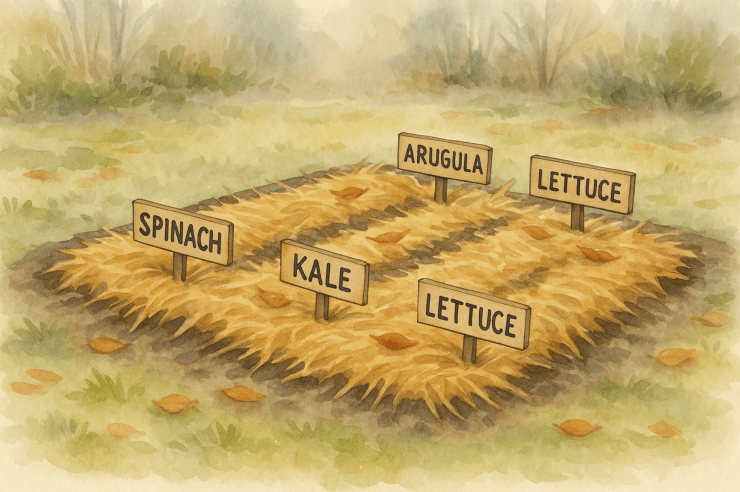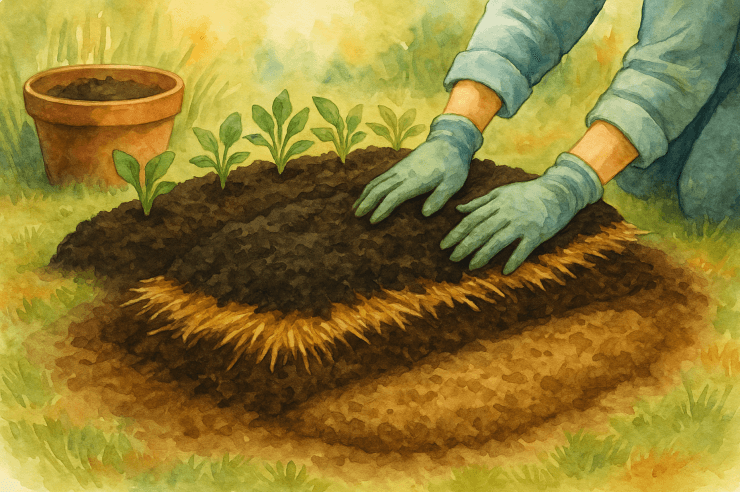Read by Matilda Longbottom
Most gardeners who practice Winter sowing are familiar with the milk jug method–planting seeds in containers that sit outside all Winter, allowing natural stratification before Spring germination. But what if there was an even simpler way? One that required no containers, no watering, and no transplanting? Enter the “seed quilt,” a brilliant technique that layers seeds directly in your garden beds with compost and mulch, creating the perfect microenvironment for natural Winter sowing.
The seed quilt method works by mimicking what happens in nature when seeds naturally fall, get covered by decomposing leaves, and emerge exactly when conditions are right. Many perennial flowers, herbs, and vegetables require cold stratification–a period of cold, moist conditions that breaks seed dormancy.
When you layer seeds between compost and mulch in September, several beneficial processes begin. The compost holds moisture while mulch prevents excessive drying, creating consistent humidity. The layered system insulates seeds from extreme temperature swings while allowing necessary cold exposure. Beneficial soil organisms slowly break down organic matter throughout Winter, releasing nutrients that become immediately available when seeds germinate. Most importantly, seeds naturally respond to soil temperature and moisture cues, emerging exactly when conditions are optimal.

Best Plants for Seed Quilting
Not every plant suits this method, but many excellent candidates respond beautifully to seed quilt treatment. Perennial flowers top the list–purple coneflower (Echinacea), black-eyed Susan (Rudbeckia), bee balm (Monarda), and native asters create stunning natural drifts when sown this way.
Lettuces and herbs are another excellent category. Many culinary varieties actually prefer this method to transplanting. Try oregano, thyme, sage, chamomile, and calendula. Self-seeding annuals like dill, cilantro, and fennel establish beautifully and often continue the cycle by self-sowing in subsequent years.
Native grasses and wildflowers establish gorgeous natural stands when seed-quilted. Little bluestem, wild bergamot, and native sedges create lovely textural elements in naturalized gardens.
Some vegetables work too, particularly cold-hardy greens like arugula, mâche (corn salad), and certain Asian greens for very early Spring harvests.
Timing and Materials
September is the magic month for most regions, though exact timing depends on your climate zone. The goal is planting after Summer heat passes but before hard freezes begin. Look for consistent nighttime temperatures below 60°F (15°C) as your signal.
Materials are refreshingly simple:
- Well-aged compost (avoid fresh compost that might generate heat)
- Fresh seeds appropriate for your zone
- Organic mulch like chopped leaves, straw, or aged wood chips
- Basic tools: rake, garden fork, watering can
- Weatherproof markers for plant identification

Step-by-Step Construction
Site preparation begins with choosing a location with good drainage and appropriate sun exposure for your chosen plants. Remove existing weeds and loosen the soil surface about 2 inches deep–it doesn’t need to be perfectly smooth.
Layer one: Spread 1–2 inches of finished compost evenly over your prepared area. This layer provides nutrients, retains moisture, and creates the perfect seed bed.
Seed sowing requires thinking like nature rather than precise garden planting. Scatter seeds by hand in natural drifts and patterns. For large areas, mix seeds with dry sand for even distribution. Plant more thickly than you would in containers–natural selection will thin the population appropriately.
Layer two: Add another thin layer of compost (1/4 to 1/2 inch) to lightly cover seeds. This protects them from birds and maintains moisture contact.
Final mulch layer: Apply 2–3 inches of chopped leaves, straw, or other organic mulch. Keep it loose and fluffy to allow air circulation while providing protection. Create small gaps where tiny seedlings can easily push through in Spring.
Initial watering settles all layers and ensures good moisture penetration. Water gently but thoroughly to moisten all layers without washing seeds around.
Winter Care and Spring Emergence
One major advantage of seed quilting is minimal Winter maintenance. Snow provides excellent insulation and slow-release moisture. Only monitor mulch for wind displacement and add more as needed, avoiding walking on quilted areas when soil is wet or frozen.
Spring emergence often begins earlier than expected, with cool-season plants pushing through late snow while warm-season species wait for consistent temperatures. As seedlings emerge, carefully pull mulch aside in small areas where you see struggling shoots, then gradually move it back around established plants for continued weed suppression.
Natural thinning becomes necessary as successful quilts often produce abundant germination. This is actually a wonderful problem–remove entire small plants rather than cutting so you can transplant them elsewhere or share with other gardeners.
Troubleshooting Common Issues
Poor germination can result from old seeds, extreme weather, or compost containing herbicide residues. Uneven emergence is natural and often creates more attractive plantings than uniform germination. Weed competition requires hand-weeding around emerging seedlings–avoid cultivation tools that might damage shallow roots.
Wildlife damage from rabbits or other herbivores may require temporary fencing until plants establish. If rodents discover your rich quilted environment, consider covering smaller areas with hardware cloth, removing it before Spring germination.
Benefits Beyond Beautiful Gardens
The seed quilt method offers compelling advantages beyond gardening success. Cost savings are substantial–direct seeding eliminates containers, potting soil, and greenhouse space while producing more plants than you can typically use.
Environmental benefits include eliminating plastic containers, reducing transportation needs, and creating immediate habitat. Native plants established this way often show superior drought tolerance and require fewer inputs than transplanted specimens.
Soil health improvement happens naturally as compost and mulch layers break down. Beneficial microorganisms flourish, earthworm populations increase, and soil structure gradually improves.
Embracing Natural Timing
The seed quilt method represents a fundamental shift from controlling nature to working with it. Instead of forcing germination in artificial conditions, this approach lets seeds experience natural conditions from the start and emerge when they’re ready to thrive.
This technique honors the wisdom encoded in seeds over millions of years of evolution. Seeds “know” when to germinate based on complex environmental cues. By creating conditions that allow these natural processes to unfold, we often achieve better results with less effort than conventional methods provide.
Perhaps most importantly, seed quilting creates gardens that feel genuinely natural because they arise from natural processes. The resulting plant communities have an authenticity and resilience that’s difficult to achieve through conventional planting methods.
Whether you’re looking to reduce gardening costs, create wildlife habitat, or simply try something new, the seed quilt method offers a rewarding path forward. This October, consider setting aside those milk jugs and embrace the elegant simplicity of layering seeds, compost, and mulch directly where you want them to grow. Your Spring garden will thank you for working with nature’s perfect timing.
Have you tried this method before? Let me know how it worked! ❖


 Previous
Previous



Don’t forget that Ruth Stout first came up with this method of using straw many decades ago and she should deserve a mention. Maybe our younger generation of gardeners haven’t heard of Ruth Stout. Ruth’s method was the way I first started gardening. The straw killed everything growing underneath it, enabling me to grow without raised beds until they came out on the scene. Not to forget Mel Barthalomew who did the first raised beds in smaller boxes, early on and had his own televised show. A lovely and very informative article in spite of my two cents!